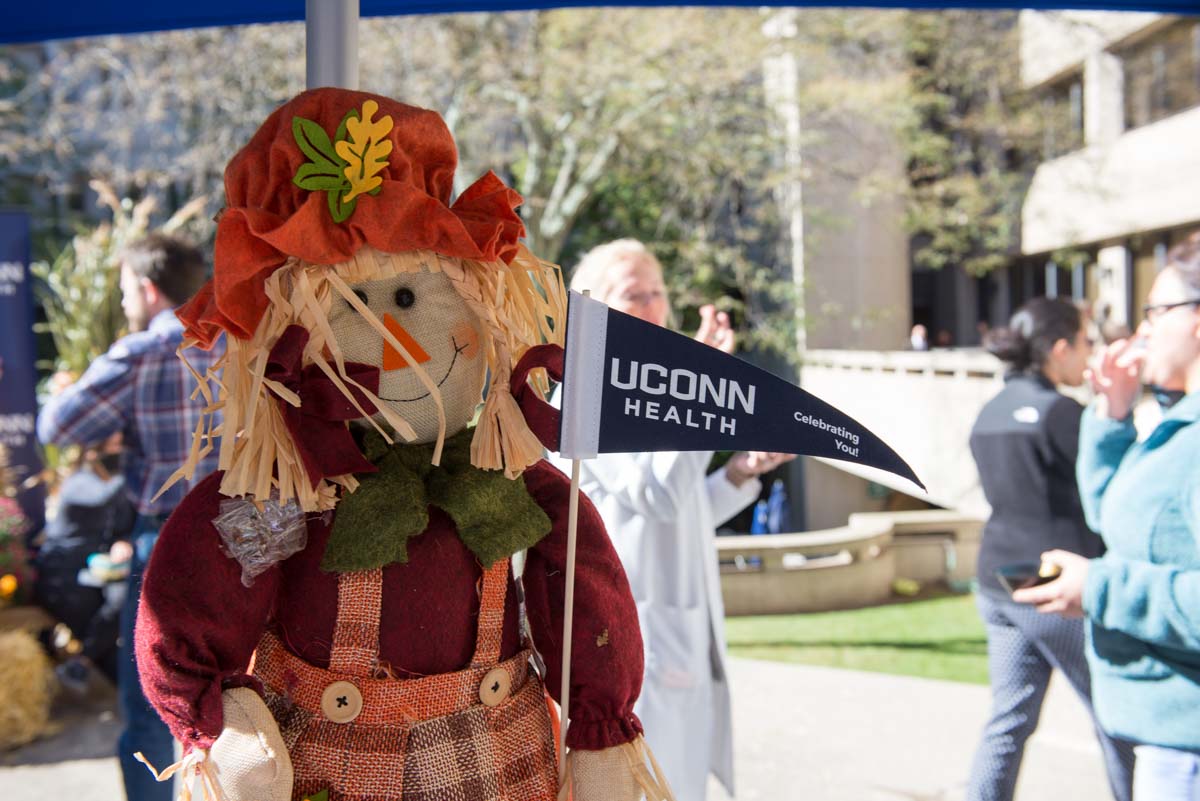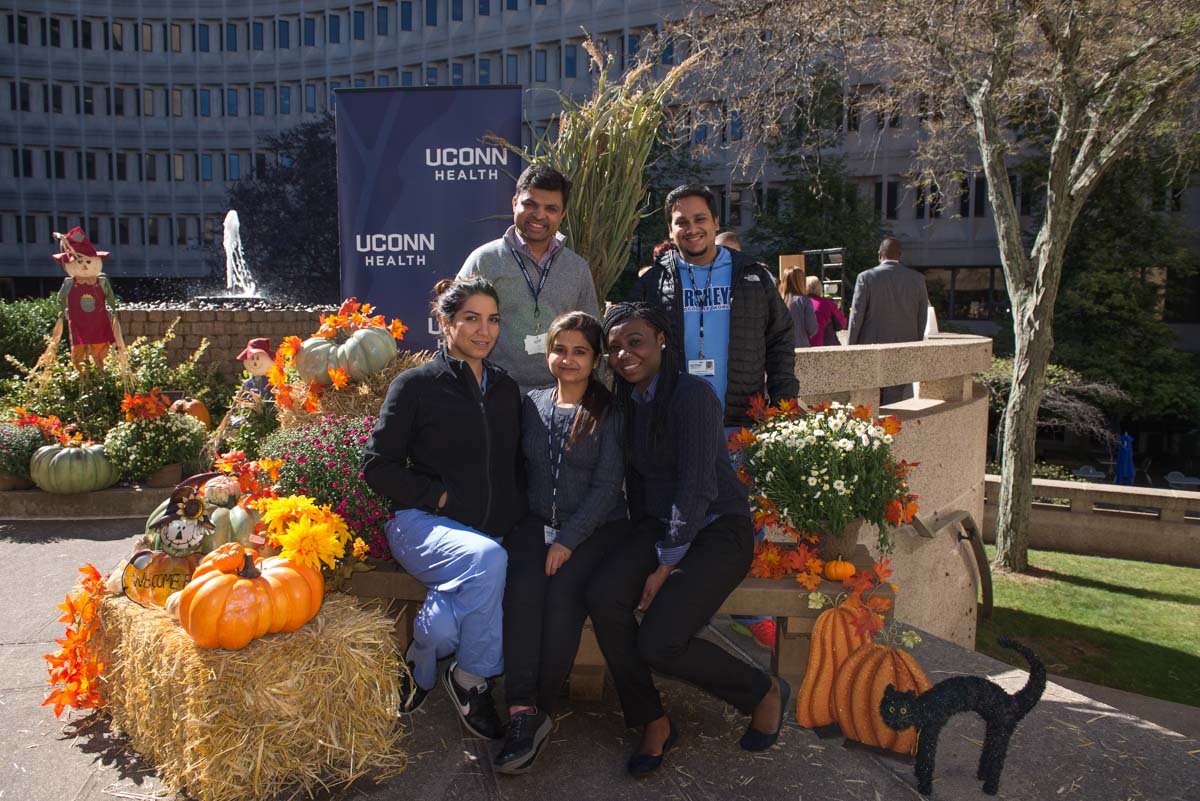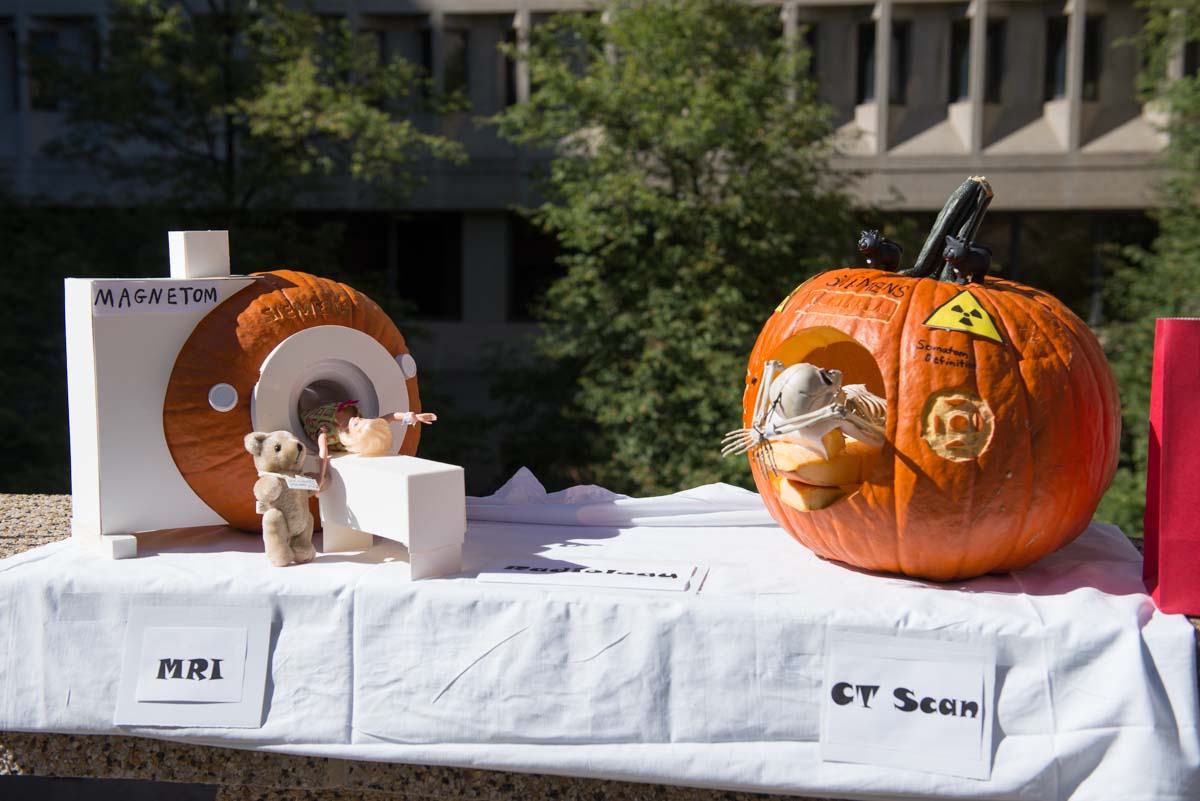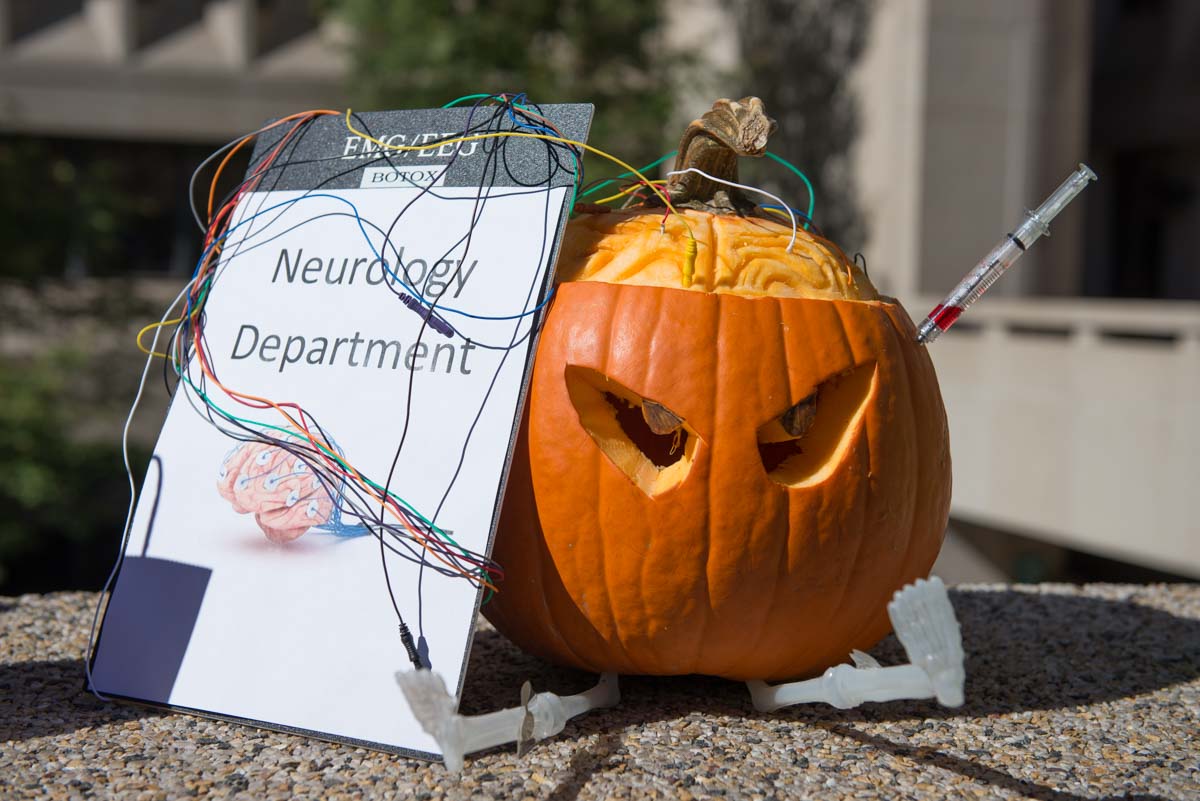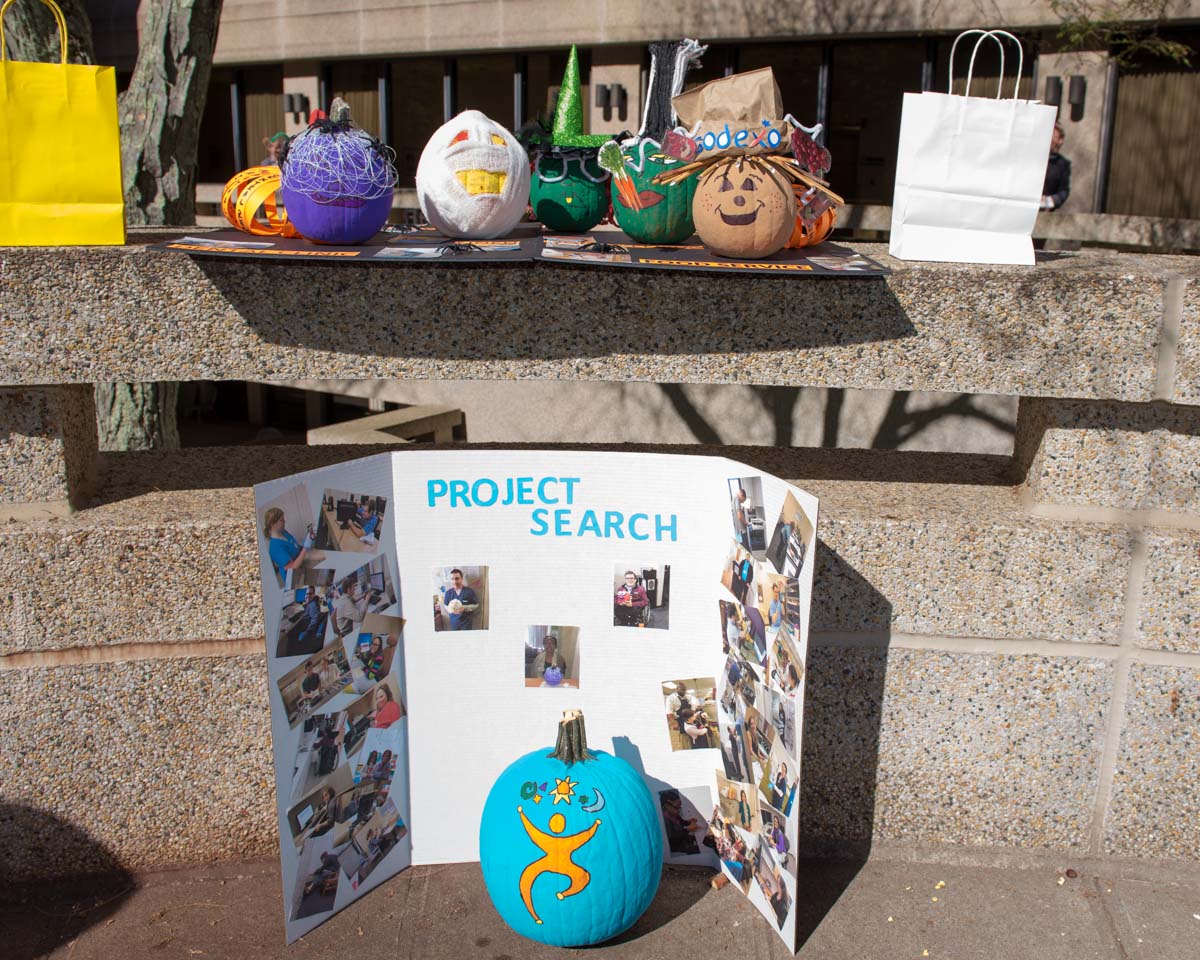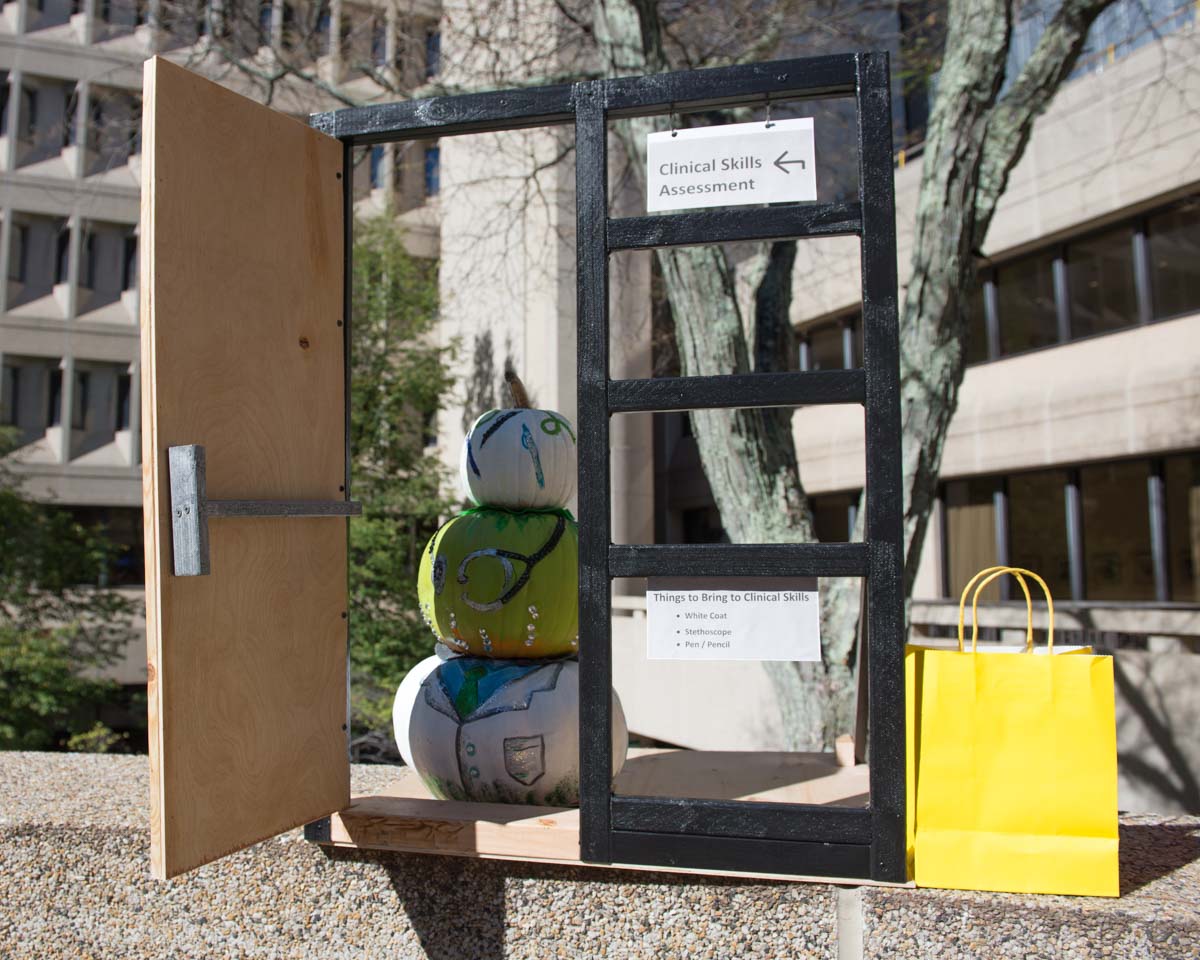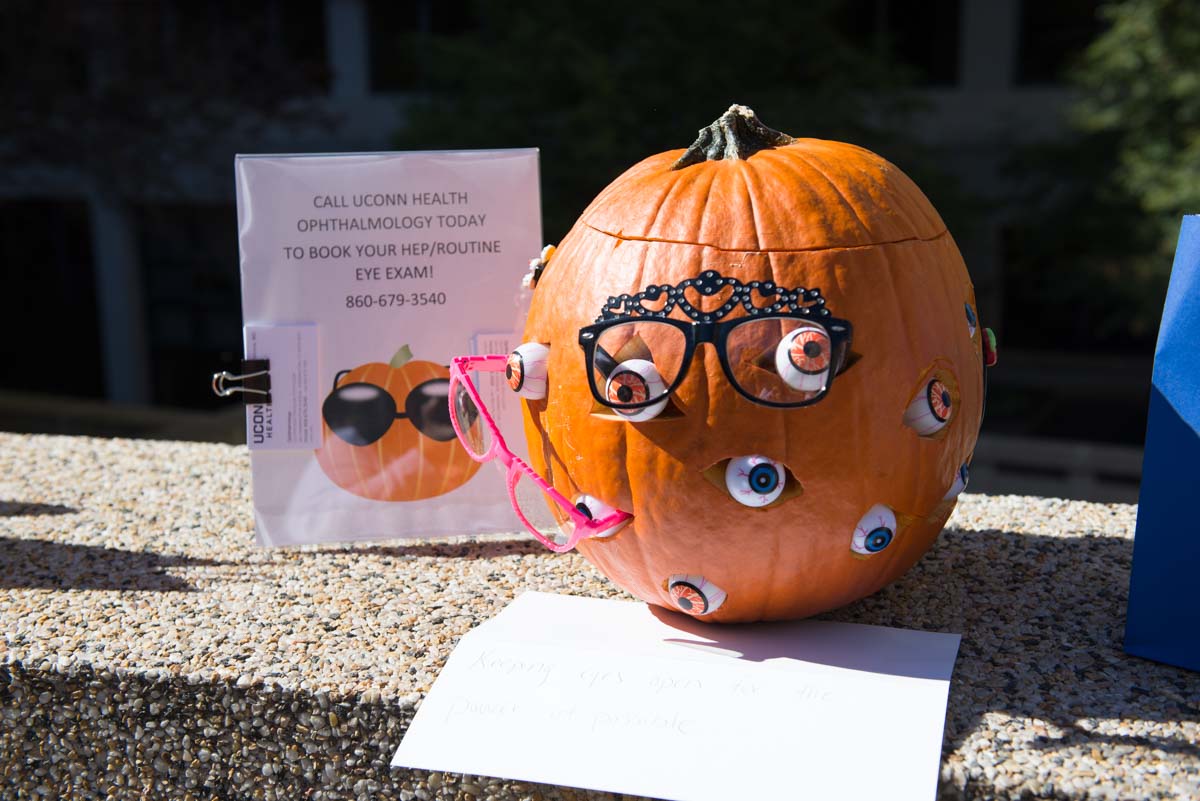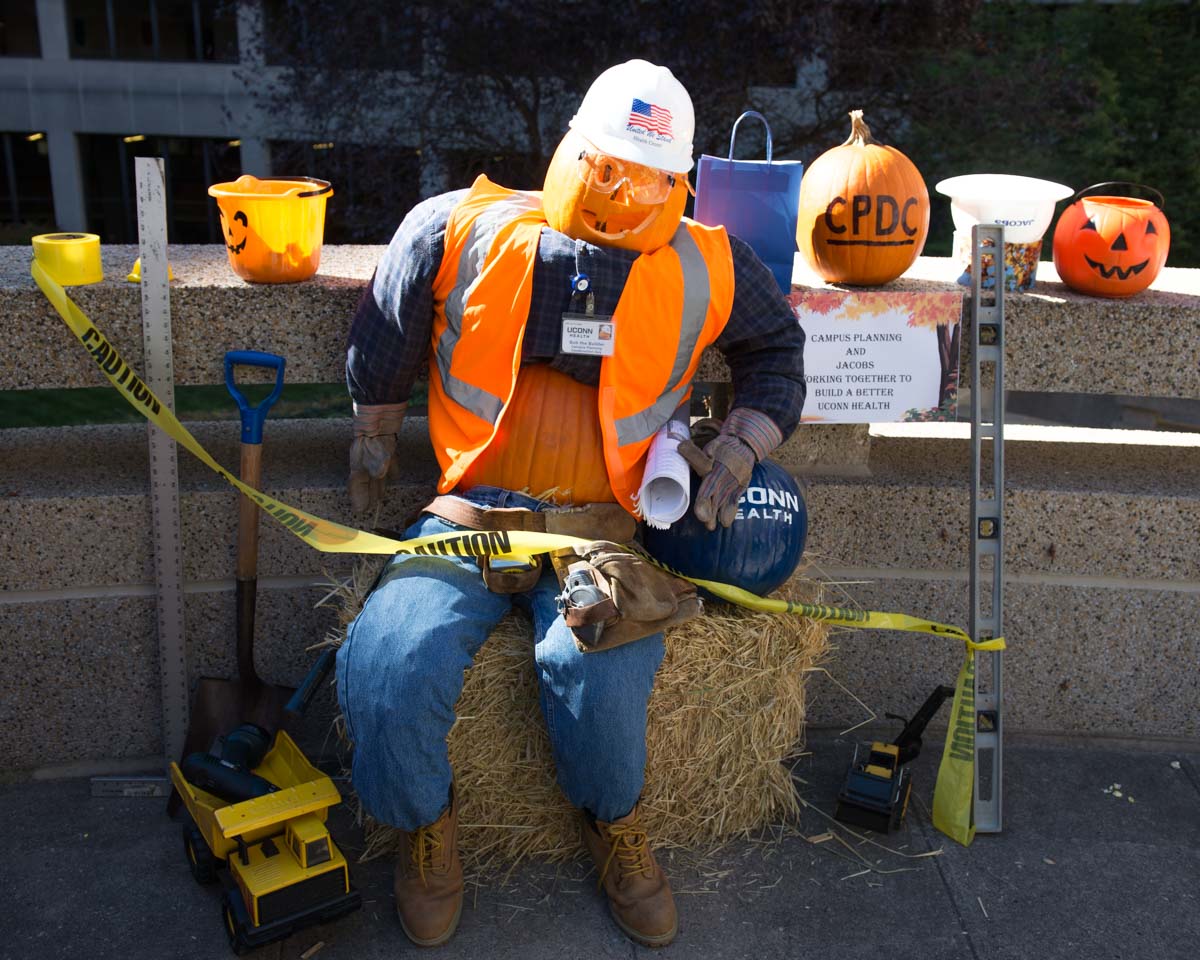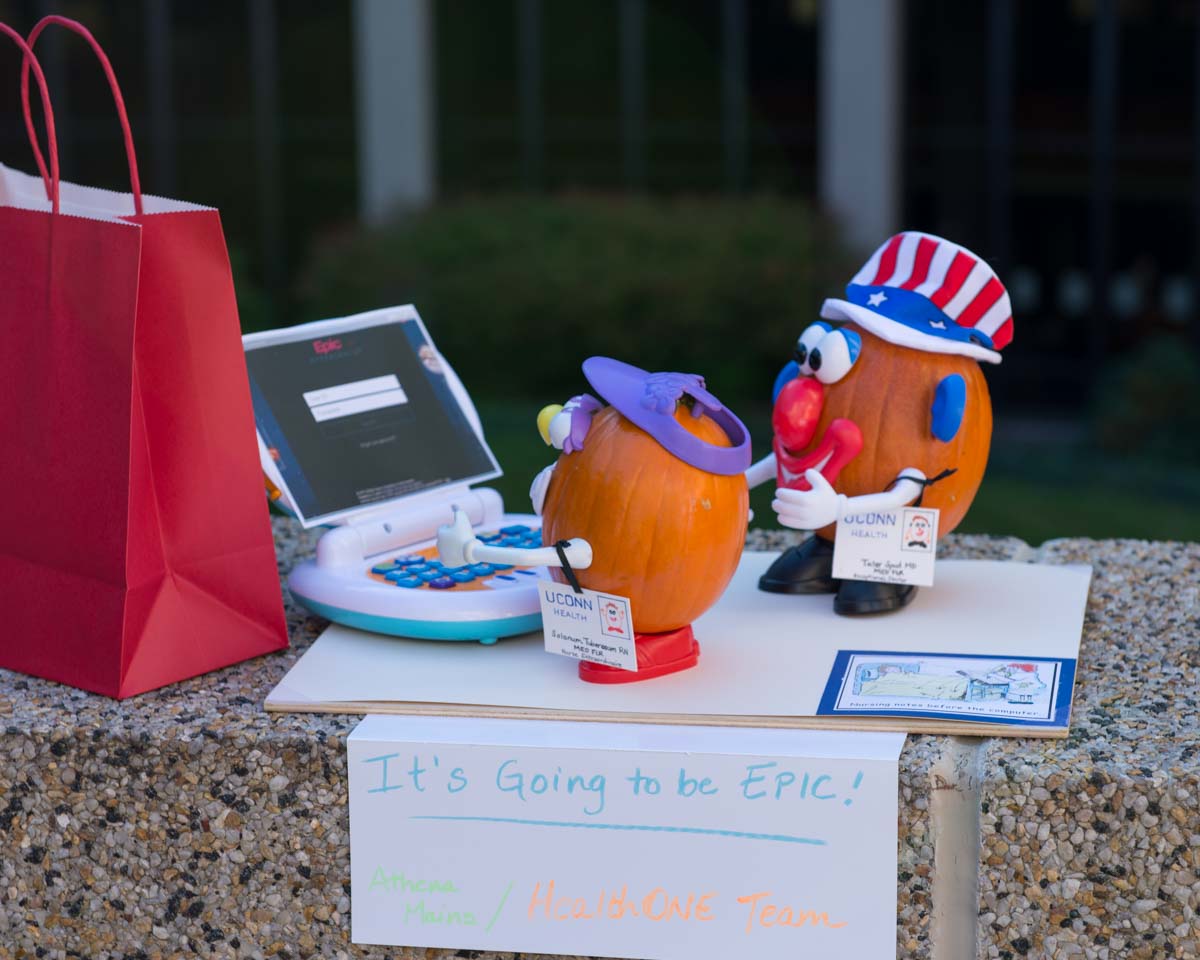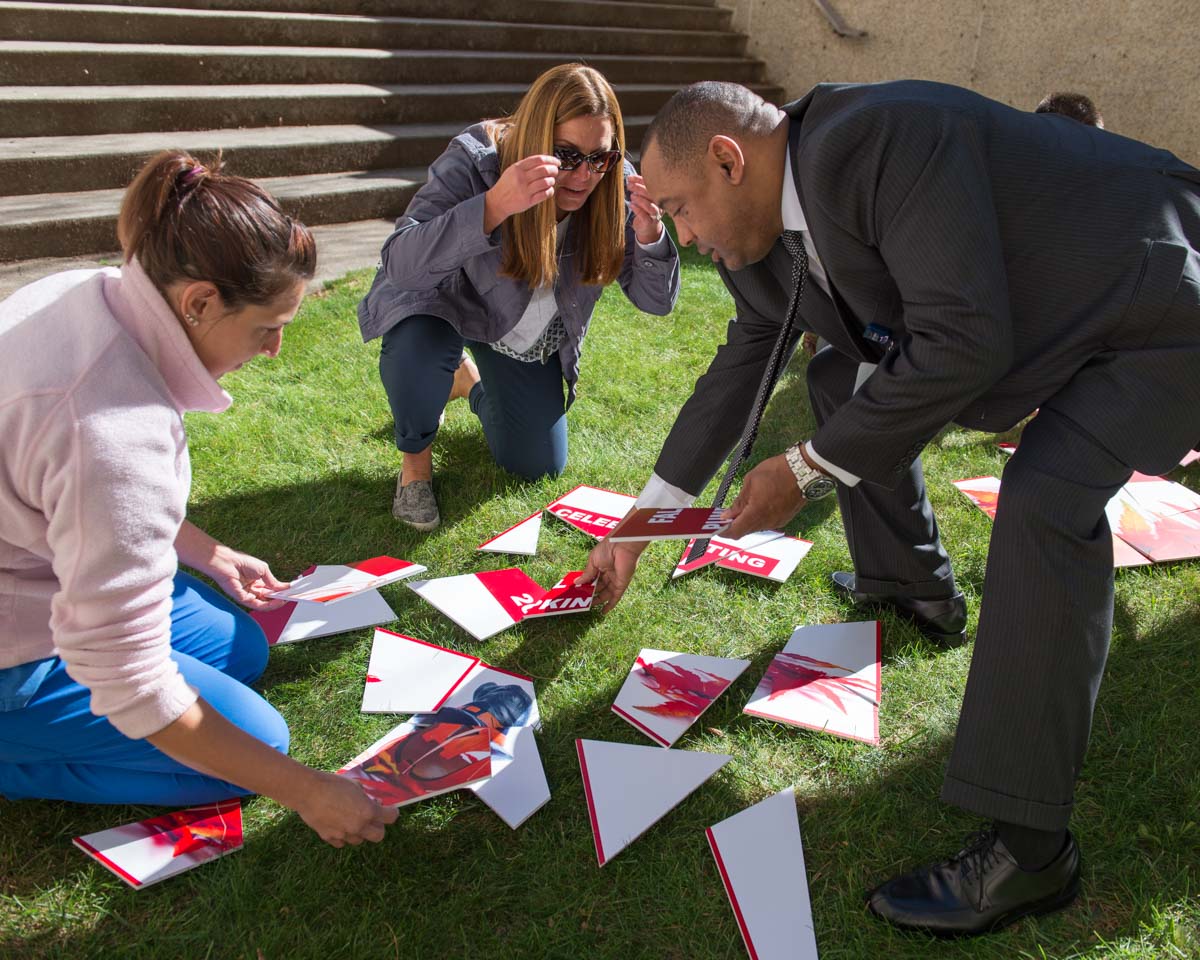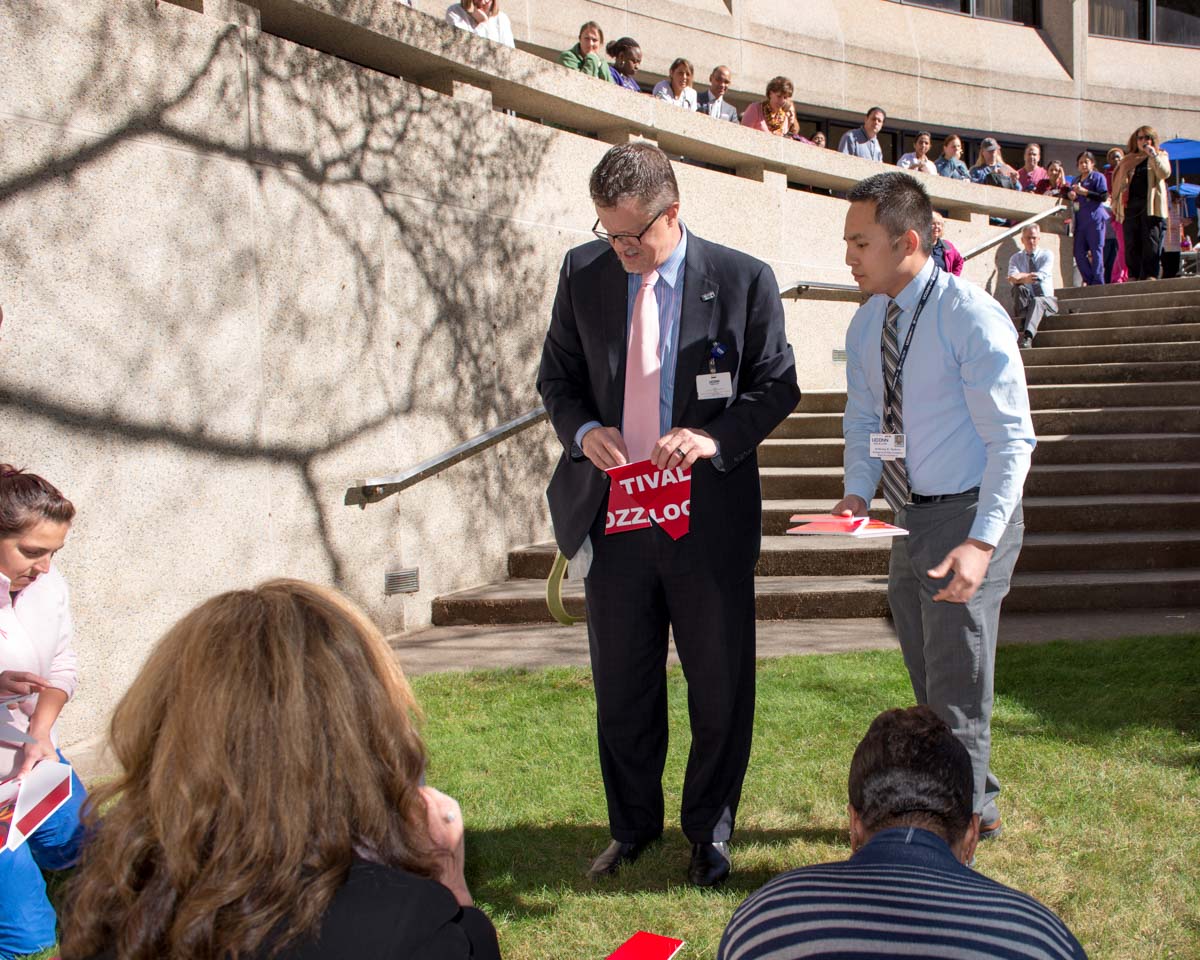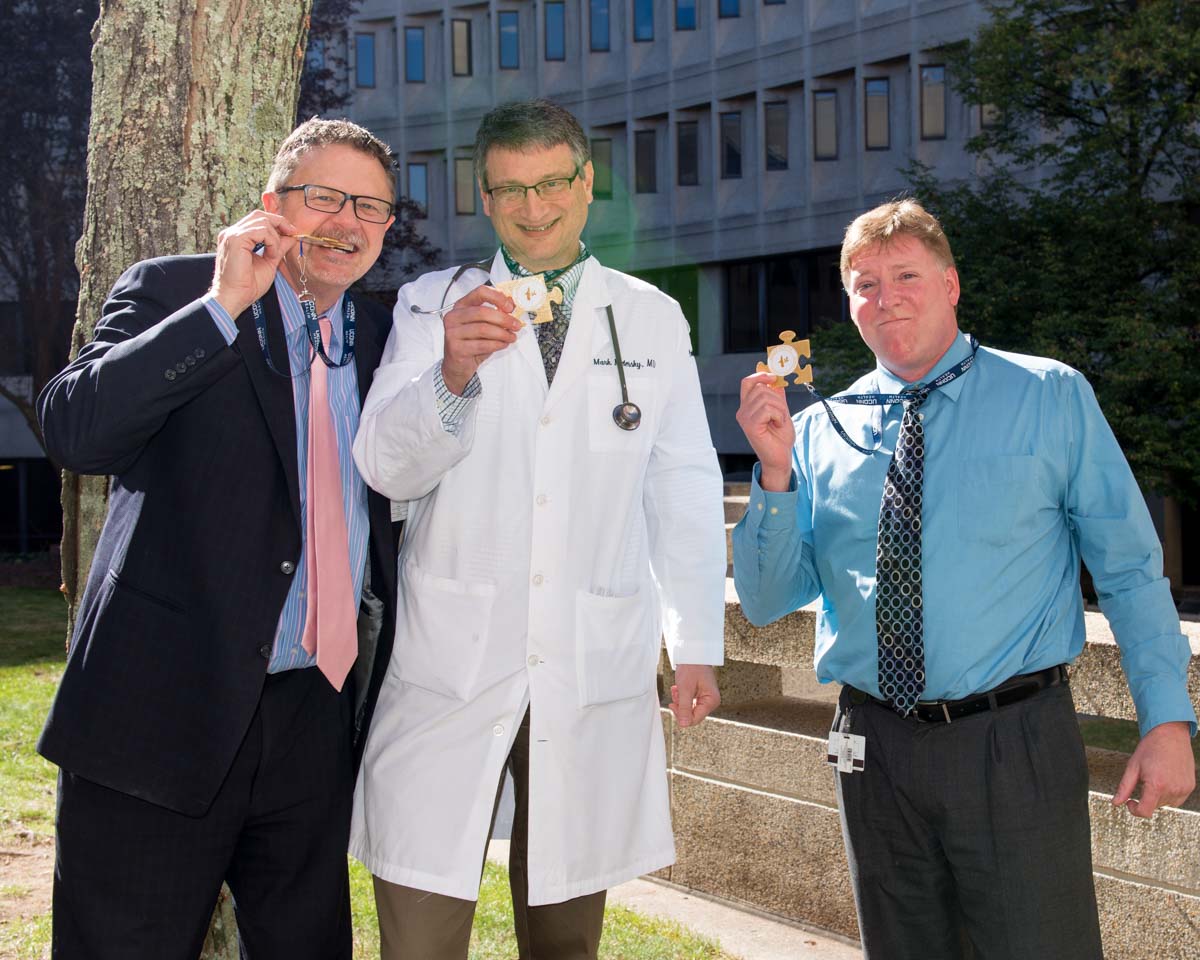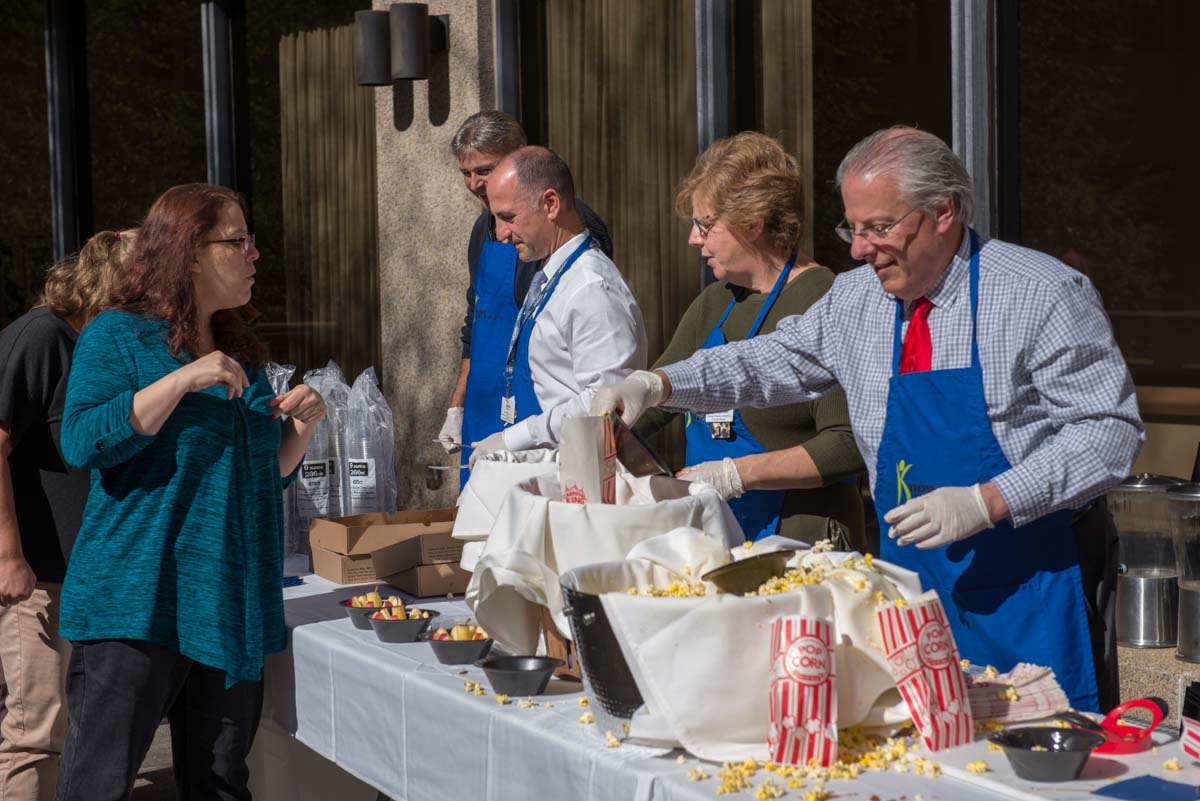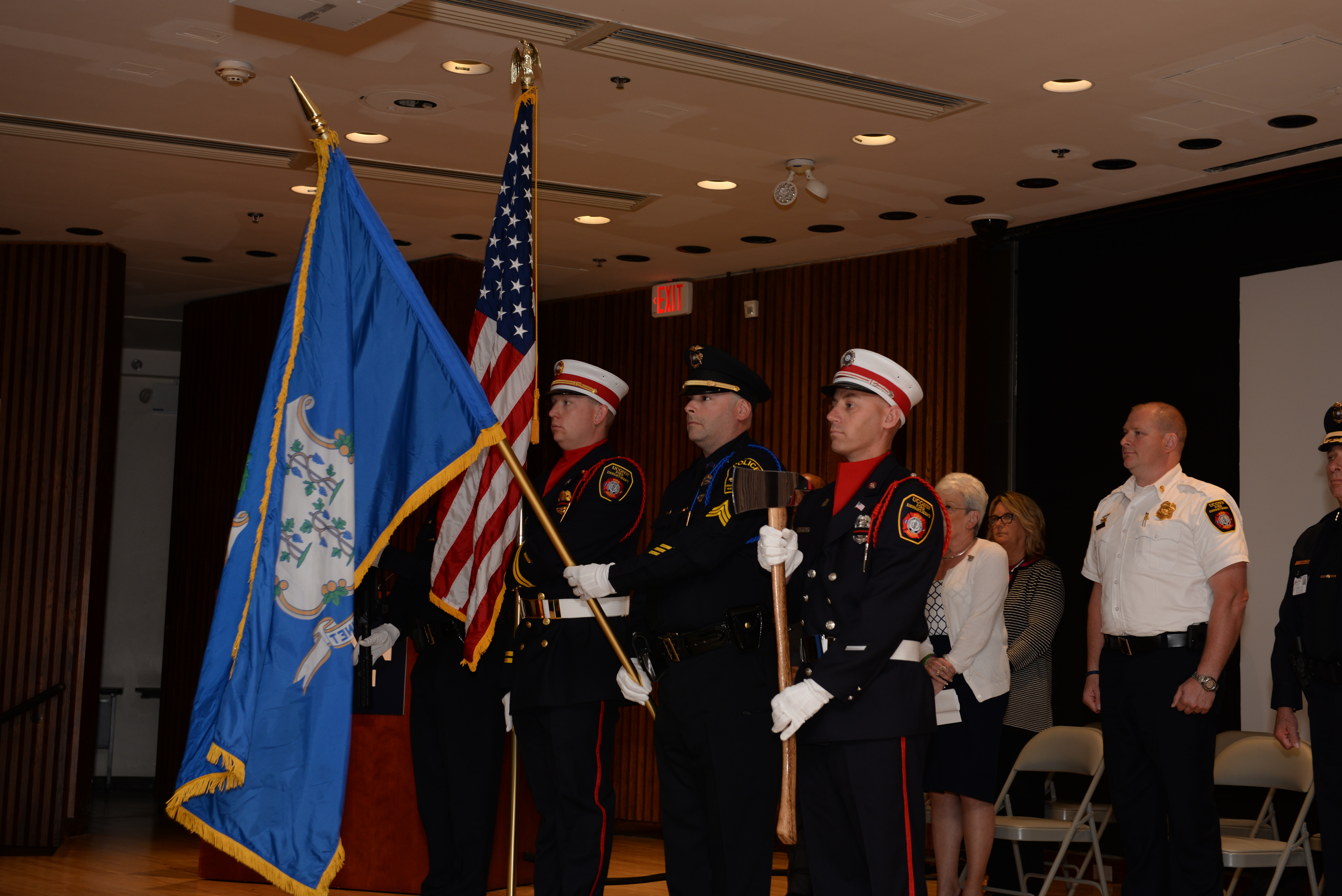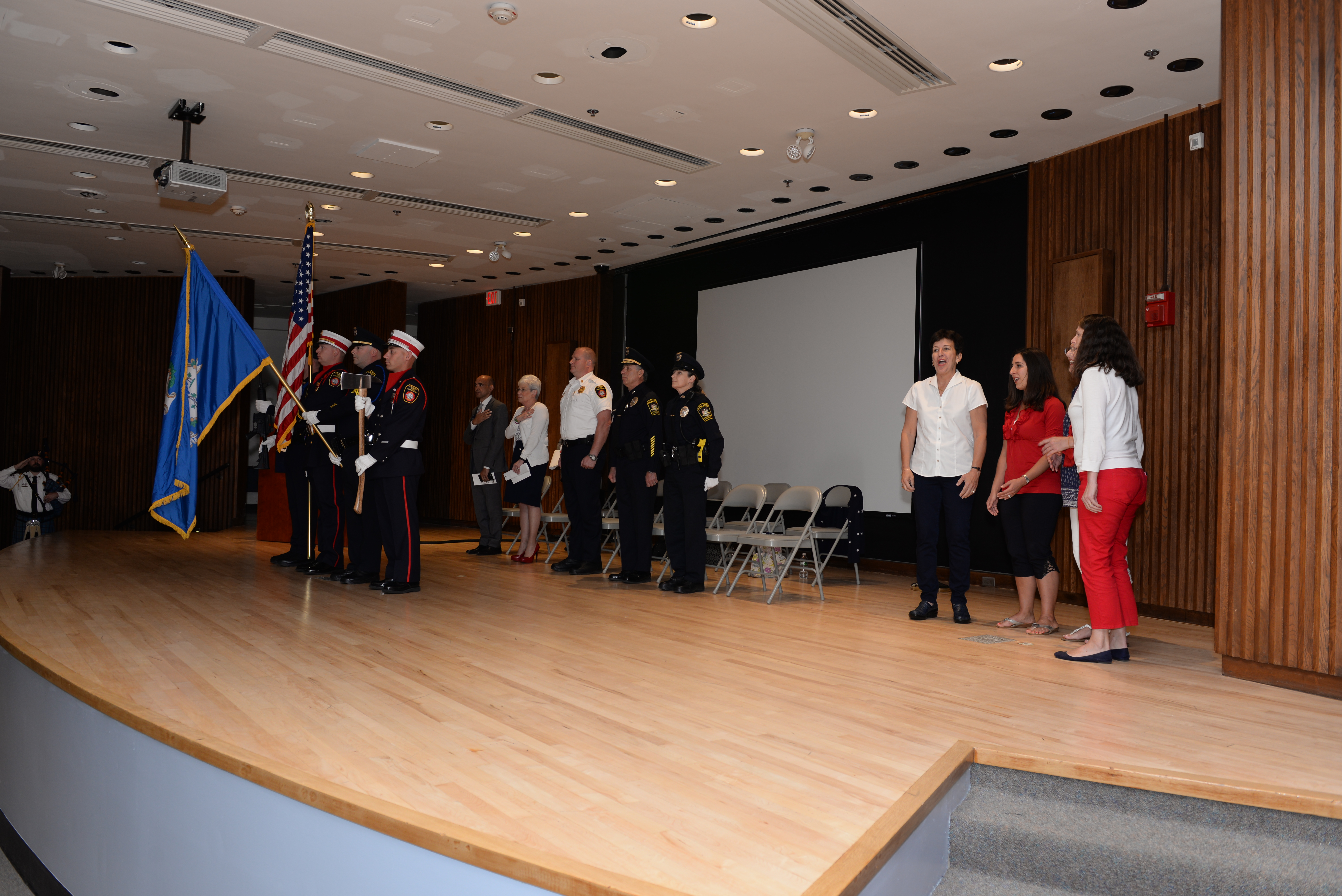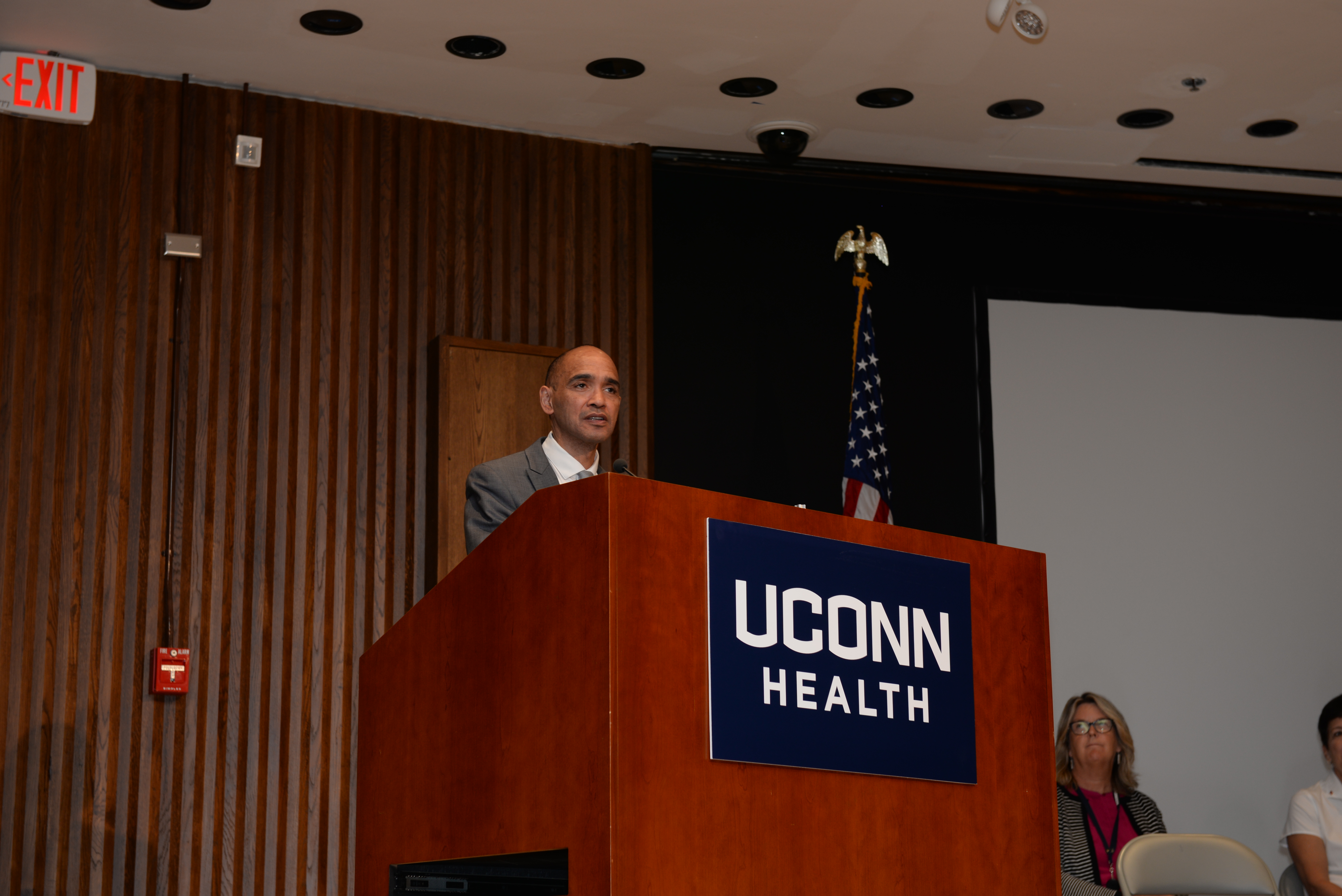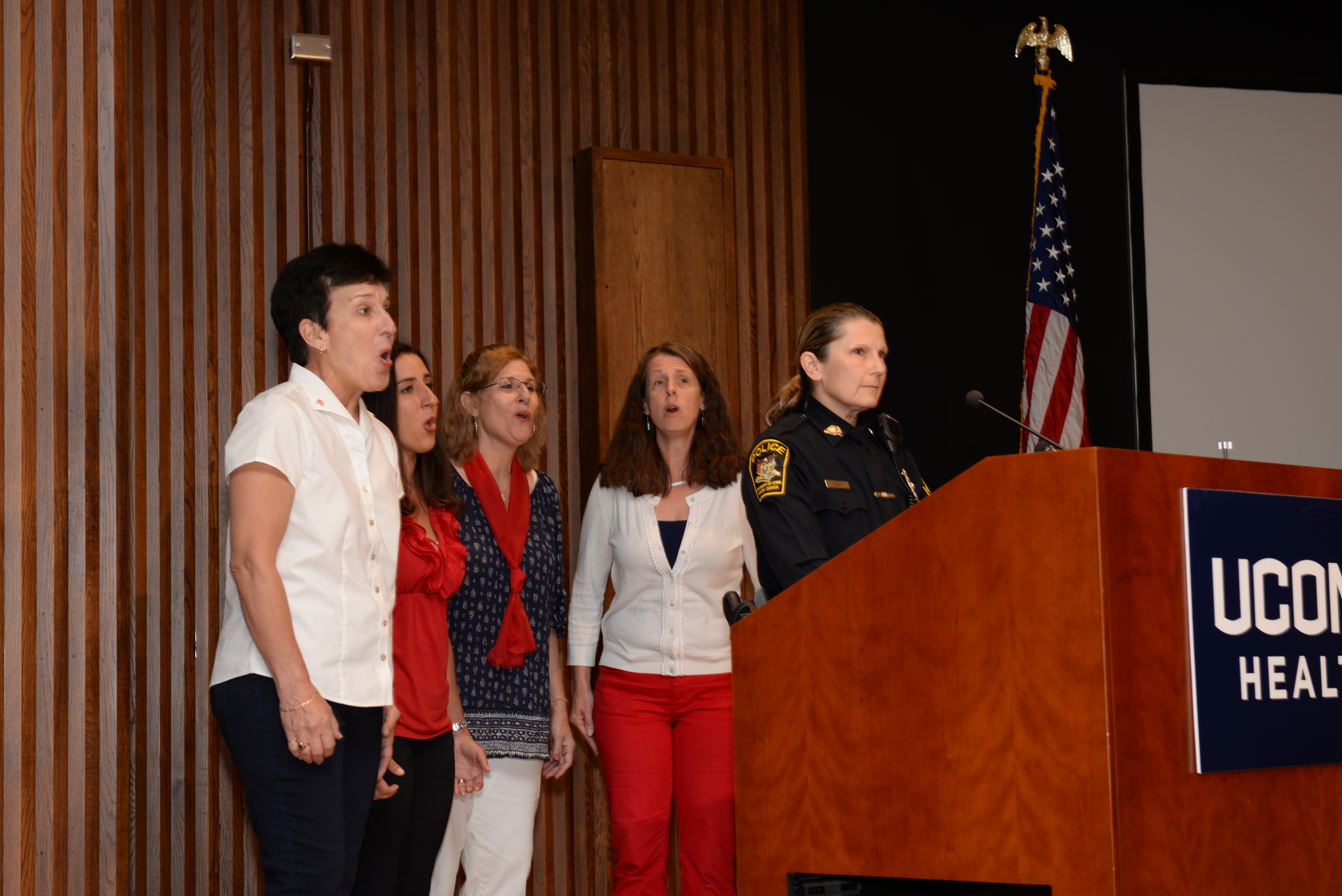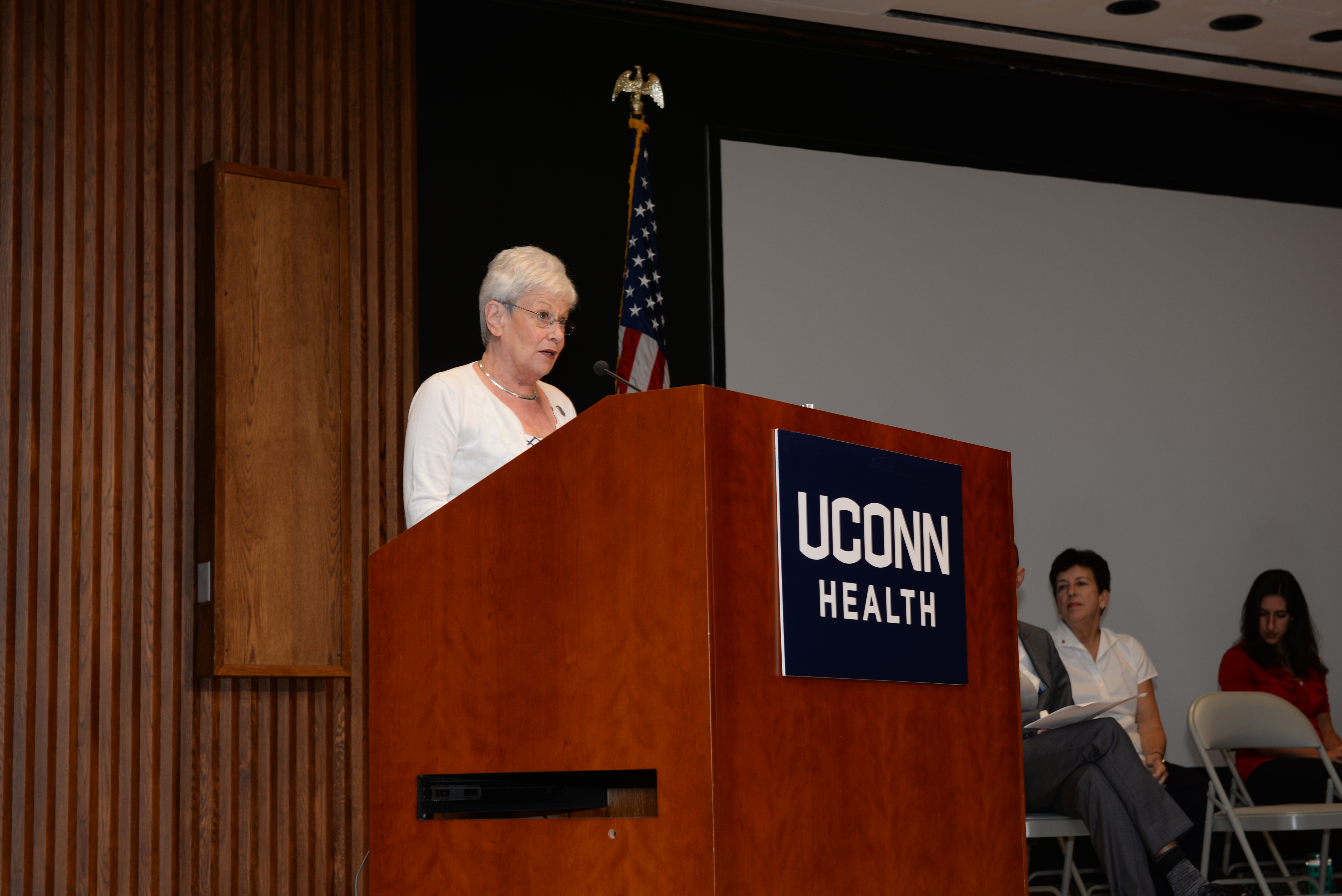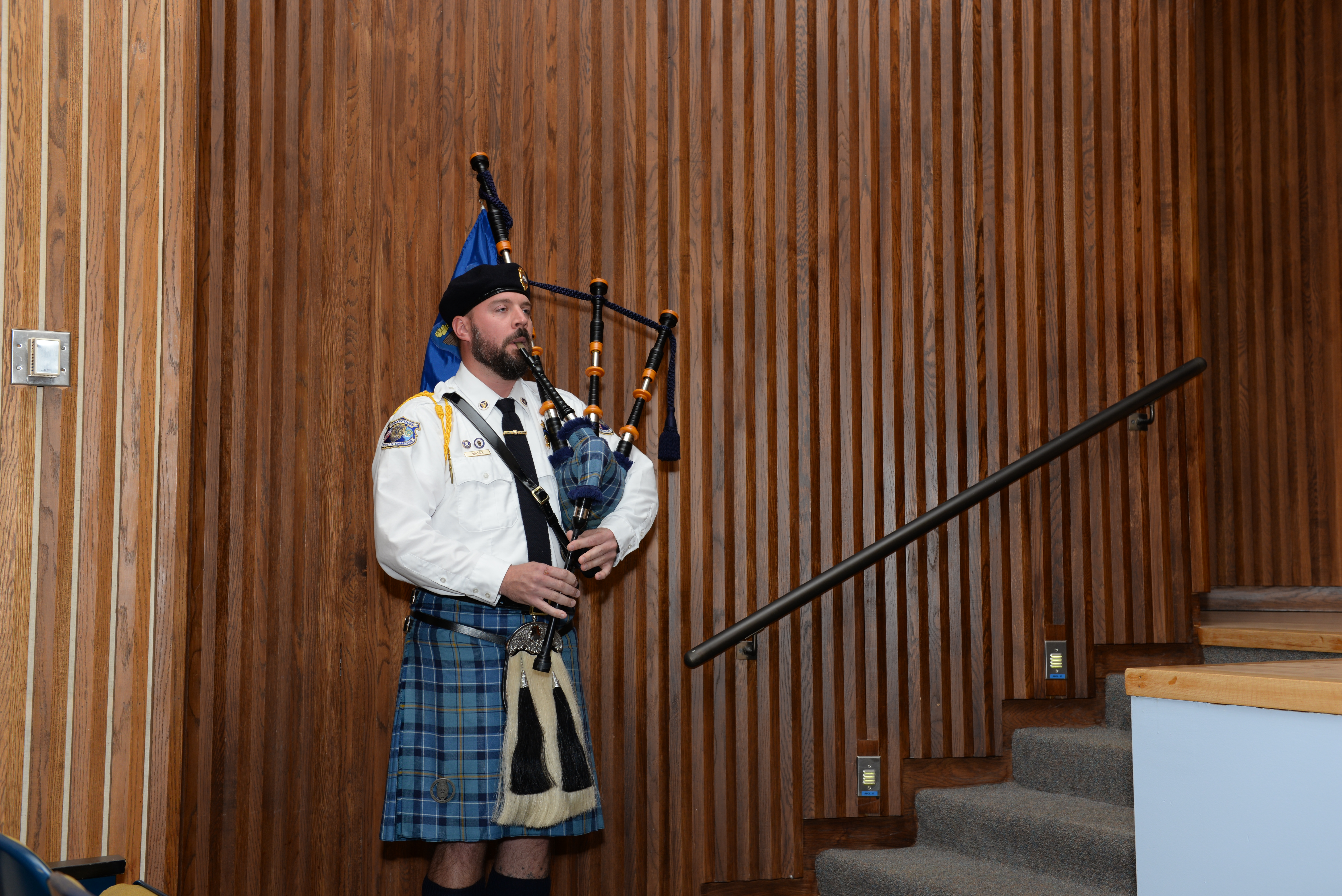Attendance was brisk with an autumn chill in the air as more than 1,000 students, employees and faculty enjoyed Tuesday’s Fall Festival in the Main Building Center Courtyard. The annual event, hosted by Human Resources, served up the traditional fall fare focusing on apples – apple cider, caramel apples, and apple cider donuts. The Pumpkin Palooza decorating contest was back by popular demand with the most entries ever (15). New this year was the Puzzle Mania competition as three teams competed to see who could assemble their UConn Health fall fun puzzle the fastest. Check the photos below to find out who won both competitions.
Pulse
Employee Engagement Survey Returns for Year 2
https://youtu.be/eYPIv4L4H6w
The 2017 UConn Health Employee Engagement Survey is now open and will remain so for the rest of this month for all regular payroll employees.
It’s the second installment in a series of three annual surveys, an effort by Dr. Andy Agwunobi, UConn Health CEO and executive vice president for health affairs, to gauge and ultimately improve employee engagement.
“For an organization to perform well, or to surmount tough challenges, everybody has to be pushing in the same direction,” Agwunobi says in a video message to the UConn Health Community. “It has to be a completed team effort, and everyone has to feel good about that and have pride in their organization.”
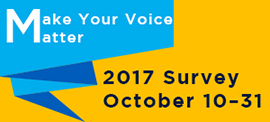 Employees should complete the survey online by way of a unique link they were emailed Monday. Responses go to a third-party administrator and are kept nonidentifiable.
Employees should complete the survey online by way of a unique link they were emailed Monday. Responses go to a third-party administrator and are kept nonidentifiable.
In 2016, the first year of the survey, the participation rate was just below 50 percent. The results—including an overall engagement score of 3.67 out of 5—led to a series of leadership development sessions and other steps taken at the management level to attempt to improve employee engagement.
Agwunobi is looking to surpass the 60 percent participation for this year’s survey.
“Your honest responses will go a long way toward helping us effectively measure employee engagement with real data and identify prospective areas of improvement within the workplace culture,” Agwunobi says.
More information about this year’s survey, including a frequently-asked questions page, is available on the Employee Engagement page on UConn Health Express.
Patient Perspective Key in Creation of HealthONE’s Patient Portal
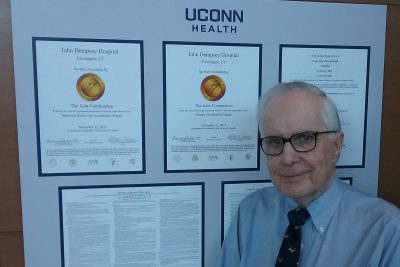
On the third Tuesday of the month, Frank Greaney of Southington has a standing appointment at UConn Health’s Outpatient Pavilion.
He is a patient, but for this hour his role is patient representative—a voice at the table where a crucial component of UConn HealthONE is taking shape.
Greaney, a founding member of the UConn John Dempsey Hospital Patient and Family Advocacy Council (PFAC), also serves on the Online Patient Engagement Committee (OPEC). This group was established earlier this year by the staff tasked with building the patient portal for HealthONE, the high-tech electronic medical record (EMR) system UConn Health is unveiling next spring.
“The OPEC members actually welcome and invite our comments,” says Greaney, a retired health care executive who, between his life’s work and his own medical challenges, has set foot in many of the country’s most successful health care facilities. “I’m impressed by the diligence of the OPEC participants and their diligent work. Everything they do has an effect on the project.”
The HealthONE patient portal will enable patients to complete such tasks as arranging appointments, requesting prescription refills, and accessing test results, all by way of a secure online account.
“My test results will be available quickly,” Greaney says. “I can run a table on my lab results for the last six months, a year, a year and a half. I can look at a summary from the last visit. I can arrange, change, or cancel appointments, and indicate the reason for my visit. It’s really going to do a lot.”
Greaney would know. He is one of two patient representatives recruited to join OPEC. Both are familiar with Epic, which provides the EMR software platform, and MyChart, which is Epic’s patient portal, from their experience as patients at other hospitals. UConn Health chose Epic as the vendor for its EMR system and branded it as UConn HealthONE.
“There’s a discipline to electronic medical records that does not exist outside the world of electronic medical records,” Greaney says. “This improves internal quality and empowers us as patients to have an active role in our care. You have your own records now. You have your own information. It’s empowering.”
OPEC members are a diverse group representing perspectives from throughout UConn Health, from patient care to billing to compliance to information technology.
With input from the patient representatives, they come up with recommendations on how to optimize the portal and make HealthONE a valuable tool for patients.
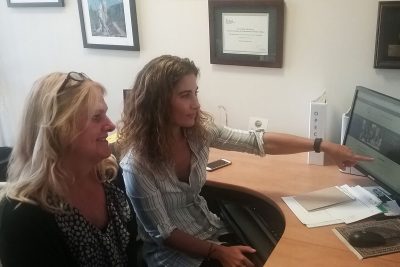
“We want to create a product that our patients are happy with,” says Bonnie Johnson, a HealthONE analyst who facilitates the OPEC meetings. “We want to make sure we not only are meeting statewide regulations, but also the expectations of our patients, because we also want to stay relevant in the marketplace.”
Topics OPEC has weighed in on so far include recommendations on screen design, support mechanisms, and timing of the portal’s introduction to patients.
“We are most pleased to have patient advocates who have joined our OPEC committee to provide a consumer perspective,” says HealthONE Ambulatory Director Kathy Noel. “The widespread perspectives shared by many across the organization allow us to discuss and determine our course through the eyes of different stakeholders.”
But that doesn’t mean the patient representatives have the final say.
“We’re here to provide perspectives, to give our opinions if asked, with the understanding that, ‘Anything we say, you are free to completely ignore,’” Greaney says. “The internal stakeholders are at the table as this program unfolds. This project requires a staggering amount of coordination. The people in this group are at the top of their respective games. And Bonnie seeks buy-in from everyone who makes this hospital work at the granular level.”
Dr. Rebecca Andrews, primary care physician and OPEC chair, says ultimately HealthONE will offer patients much more than a new and improved accessible portal for messaging.
“The hope is to engage the patient through inpatient admissions or after outpatient visits and in between episodes of care,” Andrews says. “If we develop a robust population health team, it would also be a means to reach out for testing, guideline-driven care, or needed visits to a whole group of patients at once.”
And that can only help patients, Greaney says.
“I think this is the highest-quality, safest hospital in the state,” he says. “HealthONE is a true portal, one that will open a lot of doors for the community.”
Faculty Promotions and Appointments Fall 2017
The Academic Affairs Subcommittee of the Board of Directors during its September meeting approved the following faculty promotions and appointments:
APPOINT TO:
Professor – w/award of Academic Tenure
Dr. Se-Jin Lee – Genetics and Genome Sciences
Dr. David A. Weinstein – Pediatrics
Professor – In Residence
Dr. Eric Mortensen – Medicine
Professor – Affiliated Institution
Dr. Jonathan D. Gates – (Hartford Hospital) – Surgery
Dr. Brian Grosberg – (Hartford Hospital) – Neurology
Dr. Ching Lau – (Connecticut Children’s Medical Center) – Pediatrics
Dr. William Skarnes – (The Jackson Laboratory) – Genetics and Genome Sciences
Associate Professor – Affiliated Institution
Dr. Olga H. Toro-Salazar – (Connecticut Children’s Medical Center) – Pediatrics
PROMOTE TO:
Professor – In Residence
Dr. Pamela Taxel – Medicine
Professor – Affiliated Institution
Dr. Adam Borgida – (Hartford Hospital) – Obstetrics and Gynecology
Dr. Luis F. Diez-Morales – (St. Francis Hospital and Medical Center) – Medicine
Dr. Christine M. Ohannessian – (Connecticut Children’s Medical Center) – Pediatrics
Clinical Professor – Community
Dr. Kathleen A. Marinelli – Pediatrics
Associate Professor – In Residence
Dr. Enrique Ballesteros – Pathology and Laboratory Medicine
Dr. Melissa J. Caimano – Medicine
Dr. Meghan K. Herbst – Emergency Medicine
Dr. Danielle E. Luciano – Obstetrics and Gynecology
Dr. Christopher M. Morosky – Obstetrics and Gynecology
Dr. Isaac L. Moss – Orthopaedic Surgery
Dr. Syam P. Nukavarapu – Orthopaedic Surgery
Dr. Lavern Wright – Medicine
Associate Professor – w/Award of Academic Tenure
Dr. Stormy Chamberlain – Genetics and Genome Sciences
Dr. Yusuf Khan – Department of Orthopaedic Surgery
Dr. Kamal M. Khanna – Immunology
Dr. Lisa Mehlmann – Cell Biology
Associate Professor – Affiliated Institution
Dr. Nicholas J. Bennett – (Connecticut Children’s Medical Center) – Pediatrics
Dr. James M. Feeney – (St. Francis Hospital and Medical Center) – Surgery
Dr. Daniel A. Gerardi – (St. Francis Hospital and Medical Center) – Medicine
Dr. Mark C. Lee – (Connecticut Children’s Medical Center) – Orthopaedic Surgery
Dr. Nina S. Livingston – (Connecticut Children’s Medical Center) – Pediatrics
Dr. Matthew D. Milewski – (Connecticut Children’s Medical Center) – Orthopaedic Surgery
Dr. Rebecca L. Moles – (Connecticut Children’s Medical Center) – Pediatrics
Dr. Andrea D. Orsey – (Connecticut Children’s Medical Center) – Pediatrics
Dr. James F. Parker – (Connecticut Children’s Medical Center) – Pediatrics
Dr. David S. Shapiro – (St. Francis Hospital and Medical Center) – Surgery
Dr. Cynthia Silva – (Connecticut Children’s Medical Center) – Pediatrics
Dr. Jesse J. Sturm – (Connecticut Children’s Medical Center) – Pediatrics
Dr. John R. Waterman – (Veteran’s Affairs Medical Center) – Medicine
Associate Clinical Professor – Community Faculty
Dr. Richard S.K. Young – Pediatrics
Award of Academic Tenure
Dr. Pedro J. P. Mendes – Cell Biology
UConn Board Chair’s and President’s Comments on State Budget’s Damage to UConn
Chairman Larry McHugh’s comments during the UConn Board of Trustees meeting – Sept. 27, 2017
We should all be thankful for Governor Malloy’s strong support of higher education. And those members of the Senate and House who are strong supporters of UConn.
As you know, I have been involved in supporting higher education in Connecticut for over 34 years. The Republican sponsored budget that just passed the General Assembly is probably the worst attack on public education I have seen in those 34 years. This budget is a disaster for higher ed.
I want to be clear that we are open to taking cuts. We were prepared to accept over $100 million in cuts under the governor’s budget. But this massive $300 million cut is over the top. It threatens all the progress that has been made in making our university the pride of the state and undercuts the tremendous investment that has been made in UConn.
I have always said that we need to strive for excellence and I will not apologize for supporting a university that works toward that goal.
In my work at the Chamber of Commerce, I meet and work with members of the business community all day long. The State’s economy is fragile. Regardless of the type and size of the business, the one common theme is how important it is to have a well-educated workforce.
Since a majority of our students remain here to live and work in Connecticut after they graduate, UConn is a place that these businesses count on as a source for its future hires. UConn is the catalyst for economic growth by providing the brain power, research, employees, and support to companies from start-ups to major corporations.
A strong UConn will help our economy to get back on the right track. So to make large cuts just for the sake of getting to a particular budget number is short-sighted to say the least.
Every state in the nation takes pride in its flagship university. We have just been ranked number 18 out of 132 public national universities.
Because of that, we are the envy of other states that strive to achieve that level of success. We are at a moment where our public leaders must make a choice as to whether or not they want an outstanding flagship University. So much of our economy depends on that choice. If the reputation and quality of UConn suffers, so will the economy, and it will lay squarely at the feet of those who make the public policy decision to sacrifice the University of Connecticut.
We know that we must be part of the solution and demonstrate shared sacrifice. Since 2010, we have contended with over $142 million in cuts. We never complained. When the Governor proposed a budget that would mean having to absorb another $100 million in cuts, we did not complain. We said we would do our part. Let’s be clear that those are massive cuts. But to propose triple that amount is not something we can just stay quiet about.
What I am so proud of is that the UConn Nation has come together in reaction to this budget. Members of the UConn Nation, including alumni, students, parents, patients, donors, and sports fans, are represented in every town and district of this state. They are paying attention to how this budget will impact the economy, their healthcare, critical research, student success, and the value of their degree.
Finally, I want to say how proud I am of how President Herbst has been out there defending UConn. She knows that now is not the time to sit idly by. Fighting for our budget is her job.
But let me make one thing perfectly clear. Any major cuts to programs whether at Storrs, UConn Health, or any of the regional campuses will be decided by the Board of Trustees, based on the university’s recommendations. With these massive cuts looming, EVERYTHING is on the table. The Board will make those decisions based on what is in the overall best interest of protecting this great university, and not on politics.
I pledge that we will work to keep this university a place that all of Connecticut can continue to be proud of. Stick with us. We will need all your help.
====================================================================================
UConn President Susan Herbst’s Report to the UConn Board of Trustees – Sept. 27, 2017
The last 10 days have been interesting for us at UConn, to say the least.
By now you are all well aware of the budget that was approved by the General Assembly earlier this month and what its impact on UConn would have been.
And we don’t know what the next version will bring.
Let me make 4 points:
- There is a belief in some quarters that we will not make major cuts, such as closing colleges or campuses, in the face of massive state budget cuts. We have and we will. As you recall, we – and it was hard on us and the community – closed the Torrington campus. We have closed colleges and eliminated dean positions in recent years: The College of Continuing Studies, the College of Allied Health, the College of Family Studies. I ask that folks listen to what we say and watch the hard things we’ve done in the past to cut budgets. They are not pleasant actions, but we take them when we are left with no other realistic choice.
- On the one hand, we are told we must absorb massive cuts, but are then told by some that we may not cut anything significant. Or anything people like or care about. But everything is important to someone. There is no low-hanging fruit or mythical fat adding up to $300 million, or even a small fraction of that, that could easily go.
We could zero out the salary of every single senior administrator and it would be a tiny fraction of our overall budget and barely make a dent in a $300 million reduction. So let’s get some perspective with the facts.
- Speaking of facts. I’ve been a social scientist for over 30 years, and in my work, I focus on quantitative measurement, data analysis and interpretation. There’s some very poor and woefully distorted data out there in very pretty charts on the Internet. Don’t be fooled, as hard as this is to read through.
For example, of course a university’s expenditures go up over years, when they expand their enrollment by the thousands.
And they go up because we must support advanced computing, modern educational resources, new facilities, mental health services, sexual assault prevention, legal compliance, and not to mention, actually making undergraduate education better.
There’s no free lunch for a comprehensive public university, one where the state has in fact chartered us to be comprehensive. We are glad serve our students and the state. We do it well – we are 18th public research university out of hundreds, not 50 – and we do it efficiently.
- I urge all of our folks to please continue keeping the discourse – online and in print – civil. I thank you for that, USG and our tremendous faculty and staff. Even if there are ad hominem approaches taken by others off campus, we don’t go low. The funding and support of UCONN is a public policy matter for our students and state; it’s not about me or anyone else.
I want to thank our students, faculty, staff, parents, alumni, donors and others supporters for speaking up for UConn.
We will wait and see what the new budget looks like.
Cancer Survivors Day at UConn Health Marks 20 Years
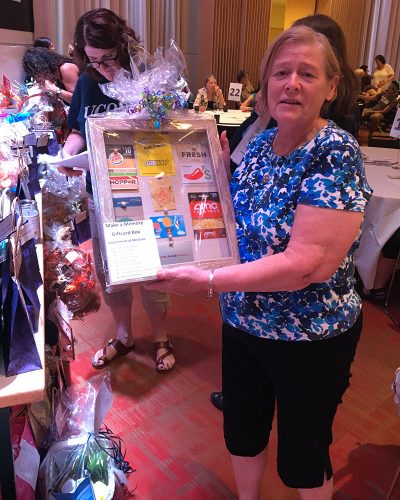
The Carole and Ray Neag Comprehensive Cancer Center celebrated its 20th Cancer Survivors Day on Sunday, Sept. 24 in the Academic Rotunda at UConn Health. The focus of the event was how you can make simple changes to your diet and exercise routine that will help you lead a healthier lifestyle.
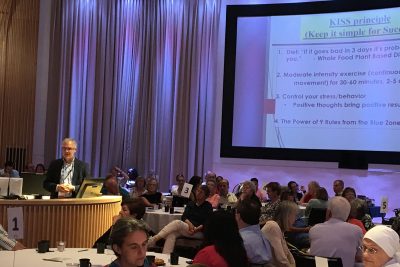
The event kicked off with Dr. Susan Tannenbuam, division chief of Hematology and Medical Oncology, telling the many survivors and their families that, “you are the most important people in the room and we are all here for you.” She then introduced Dr. Elektra Kaloudis, section head of Thoracic Imaging at UConn Health, who bravely shared her cancer journey and how she pushed through the scary times by focusing on her young children.
Dr. Kaloudis was followed by Brad Biskup, the physician assistant leading the Lifestyle Medicine Program at UConn Health. Biskup discussed some simple diet and exercise changes you can make that will lead to a healthier you.

Terry Walters, a local author of the book “Eat Clean Live Well,” held a cooking demonstration to prove that, with a little bit of planning, you can prepare healthy and tasty snacks.
Norm (Craig) Smith, a breast cancer survivor, said the speakers resonated with him since he’s been working to get back into shape and eat better. “These presentations really helped us with the tools we need to kick start that process. Taking one step at a time towards healthy foods and getting more active are the two take-aways we heard.”
Survivors were also treated to a raffle in which numerous departments at UConn Health and Storrs campus, local businesses, and individuals generously donated gift baskets, gift cards and services.
Wellness Center Opens Next Month
It’s only a matter of weeks now before students, staff and faculty have their own wellness center.
UConn Health is dedicating more than 3,600 square feet to an around-the-clock, badge-access facility that will offer 13 cardio machines, 9 resistance machines, free weights, locker rooms with showers, and a healthy vending machine. It also will have two rooms for fitness classes such as yoga, pilates, Zumba, behavioral counseling, and stress management.
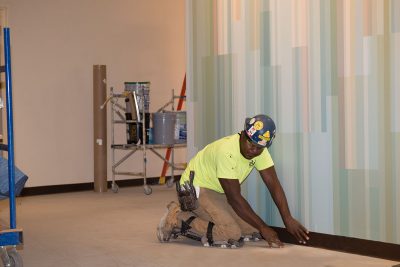
The location is the main floor on the academic side of the main building, in what formerly was known as the Friends Lecture Room (LM 034).
Scheduled to open by late October, the wellness center will also will be available to graduate students and residents. Details on the enrollment process and membership fees are to be announced shortly.
“This is something the UConn Health community has been asking us about for a very long time,” says UConn Health Chief Adminstrative Officer Carolle Andrews. “The facility is part of a larger vision of student and employee wellness we are offering on campus as we strive to become an even greater example of health and well being, given our mission of public health and public service.”
The wellness center will have a coordinator whose duties will include managing the membership, overseeing the fitness programs, and communications.
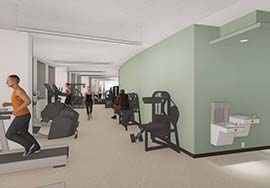
The fitness equipment is on order and will include:
- 4 commercial treadmills
- 4 adaptive motion trainers
- 2 step machine
- 3 stationary bicycles
- 1 leg extension/ curl
- 1 chest press
- 1 bicep curl
- 1 abdominal machine
- 1 glute extension
- 1 back extension
- 1 lateral pulldown/row
- 2 benches/utility seats
- 1 dumbbell – weight stack
- 18 yoga pads
- 1 plyometric box
- 2 medicine balls
- 2 kettle bells
In the coming months, the wellness center will have a website that will include fitness class schedules and a form to register for them.
Ceremony Marking the 16th Anniversary of September 11
Bryan Gran, Man With a Plan: Hurricane Readiness
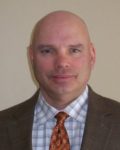
Are you ready for the next disaster? If your answer is no then chances are you need a plan.
September is National Preparedness Month (NPM) and serves as reminder that we must be prepared for any and all types of emergencies and having a plan for yourself, family and friends will go a long way to achieve this. This year’s theme is “disasters don’t plan ahead. You can”.
Hurricane Ready
Protecting Family, Pets and Property.
To do this you need to:
- Have a shelter in-place plan
- Have an evacuation plan
- Have a communication plan
- Have preparedness kits
- Prepare your property ahead of time
- Be prepared to evacuate
- Protect important documents
Hurricane readiness starts with you. Be UConn Health ready, be hurricane ready.
—Bryan Gran
Looking at Hurricane Harvey and its catastrophic impact to Texas emphasizes the importance of planning and being prepared. Signing up for alerts and warnings in your area, having a communications plan, knowing your evacuation routes, meeting locations, sheltering plan and securing important documents are just a few of the many things you can discuss with family, friends, and your co-workers.
Now is the time to make a plan, or if you have one take the time to test it and update it as necessary. For more information on making a plan visit https://www.ready.gov/make-a-plan.
When you know a hurricane is coming and it’s time to put your evacuation plan into place, what’s next?
- Once you receive notification to evacuate take action and begin necessary movement to put your plan in place.
- Listen and more importantly take directions from government officials as many others will be receiving the same instructions, roads may be closed and hazards may exist that you are not aware of.
- Know where you’re going and how to get there.
- Make a kit and ensure you include important documents and those items needed to sustain you.
FEMA also has a guide on preparing specifically for a hurricane.
–Bryan Gran
HealthONE Ramping up Testing, 8 Months From Go-Live

The employees and consultants who are overseeing UConn Health’s conversion to a modern electronic medical record system are now well into what is probably the most important stretch of the testing phase.
The second of five planned rounds of integrated testing is underway. If you liken it to a theater production, the show has been cast and the actors know their lines, and now they’re starting to rehearse together on stage.
In this case, the stage is the fourth floor of the Connecticut Tower, which has been converted into an area designated for this purpose through the end of December. Integrated testing started July 31 and represents the largest part of the overall testing phase.
“Each analyst represents a different piece of the system,” says HealthONE business system analyst Margo Higginbotham. “They’ve kind of been in their little silos for a while now. When we say integrated, it’s them now coming together and saying, ‘Oh, so when I do that, it affects you.’ That’s the whole point of this, to identify defects now so next time we run them, we’ll see if it makes it through.”
There are nearly 150 scripts, or workflows, to test over the next three months to determine which pieces of the process are working properly. These scripts represent approved current and future state patient workflows and how HealthONE will handle them, for example from registration to admittance to recovery to medications to discharge and billing.
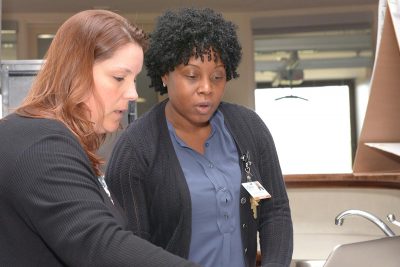
“Now is the time to find those defects in between each of their applications, or something that would have executed in one system but isn’t working as planned when integrated with another application,” says HealthONE application architect Trisha Faraday. “Those are the defects that we’re now finding.”
During the first three weeks, or Round 1, the analysts ran 95 scripts, 34 of which passed. They expect to execute most of the rest during Round 2, which started this week. Some of the scripts that didn’t pass in Round 1 are back in Round 2 to see if the defects have been successfully resolved. Others need more time to be fixed and will return to testing in Round 3.
“Testing it now in this environment is where you’re going to be able to fix it with the least amount of impact to the user,” Faraday says. “This will make things run smoothly and efficiently when we’re ready to present it to the end users during the workflow walkthrough this fall.”
A better than 33 percent pass rate far surpassed expectations for the first round.
“We got off to a great start,” Higginbotham says. “Round 1 confirmed that our adoption, build, and testing efforts so far have been successful. It also helped us zero in on early opportunities for improvement.”

Faraday, Higginbotham, and Donatienne Noel, a consultant with experience with Epic, the HealthONE software vendor, make up the quality assurance group, which facilitates the integrated testing. They serve as a support system to the analysts.
“The testers are executing their scripts diligently; and are seeing the bigger picture of the application and how it is fully integrated,” Noel says. “The practice of testing is allowing them to verify whether the actual build matches the expected results and to ensure that software system defects are at a minimum prior to go-live.”
The overall testing phase is scheduled to run through the end of March and overlap with end-user training, which is scheduled to start Feb. 1. The go-live date is April 28.
“Probably the most encouraging thing is how well the analysts work together in the testing room,” Faraday says. “They go in there with a great mindset of, ‘We’re going to get this script done,’ and they really work as a team.”
More information about HealthONE is available at uconnhealthexpress.uchc.edu/emr.
